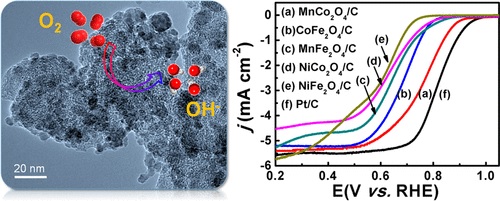韩敏教授课题组在ENERGY & FUELS发表研究论文
Versatile Synthesis of Ultrafine Ternary Spinel Oxides/Carbon Nanohybrids toward the Oxygen Reduction Reaction
Zhao, SL (Zhao, Shulin)[ 1,2 ] ; Guo, T (Guo, Tao)[ 2 ] ; Fan, JY (Fan, Jiayao)[ 1 ] ; Wang, L (Wang, Lei)[ 1 ] ; Han, M (Han, Min)[ 1 ]*(韩敏); Wang, J (Wang, Jing)[ 2 ] ; Wu, YP (Wu, Yuping)[ 2 ] ; Chen, YH (Chen, Yuhui)[ 2 ]*
[ 1 ] Nanjing Normal Univ, Sch Chem & Mat Sci, Jiangsu Key Lab Biofunct Mat, Jiangsu Key Lab New Power Batteries, Nanjing 210023, Jiangsu, Peoples R China
[ 2 ] Nanjing Tech Univ, Sch Energy Sci & Engn, State Key Lab Mat Oriented Chem Engn, Nanjing 211816, Jiangsu, Peoples R China
ENERGY & FUELS,202007,34(7),9069-9075
Designing cheap and highly efficient electrocatalysts for the oxygen reduction reaction (ORR) is vital to advance fuel cells or metal-air battery technologies. Although great progress have been obtained, facile and versatile synthesis of ternary spinel oxides (AB(2)O(4)) and carbon nanohybrids (NHs) remains a challenging work and their applications in ORR have not been systematically investigated. In this work, a series of ultrafine AB(2)O(4) nanocrystals/Vulcan C NHs, including MnCo2O4/C NHs, CoFe2O4/C NHs, MnFe2O4/C NHs, NiCo2O4/C NHs, and NiFe2O4/C NHs, are synthesized by directly refluxing bimetallic precursors and carboxylic-functionalized Vulcan C in an environmentally friendly solvent, i.e., 1,3-dimethyl-3,4,5,6-tetrahydro-2(1H)-pyrimidinone. This strategy does not need a high temperature, long reaction time, and post-annealing treatment, which is a simple, green, and easy method for scalable synthesis. In those NHs, all of the AB(2)O(4 ) nanocrystals are ultrafine (similar to 5 nm) and dispersed uniformly on the C support. Among them, MnCo2O4/C NHs exhibit the highest catalytic activity, with an onset reduction potential of 0.96 V [versus reversible hydrogen electrode (RHE)] and a half-wave potential of 0.754 V (versus RHE). Related electrocatalytic dynamic tests reveal that the ORR mechanism follows the direct "4e -" process, and only 11.1% HO2(-) yield is generated at 0.5 V (versus RHE). As revealed from the microstructural and electrochemical measurement, the superior catalytic performance of MnCo2O4/C NHs can be attributed to their high specific surface area and low interfacial electron transfer resistance in relation to other AB(2)O(4)/C NHs.

文章链接:
https://pubs.acs.org/doi/10.1021/acs.energyfuels.0c01901
版权与免责声明:本网页的内容由收集互联网上公开发布的信息整理获得。目的在于传递信息及分享,并不意味着赞同其观点或证实其真实性,也不构成其他建议。仅提供交流平台,不为其版权负责。如涉及侵权,请联系我们及时修改或删除。邮箱:sales@allpeptide.com